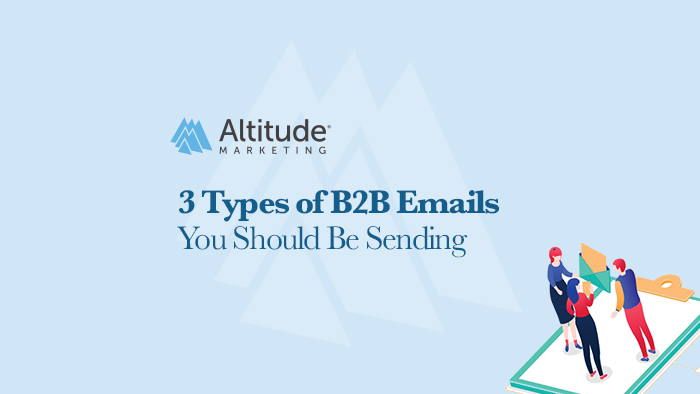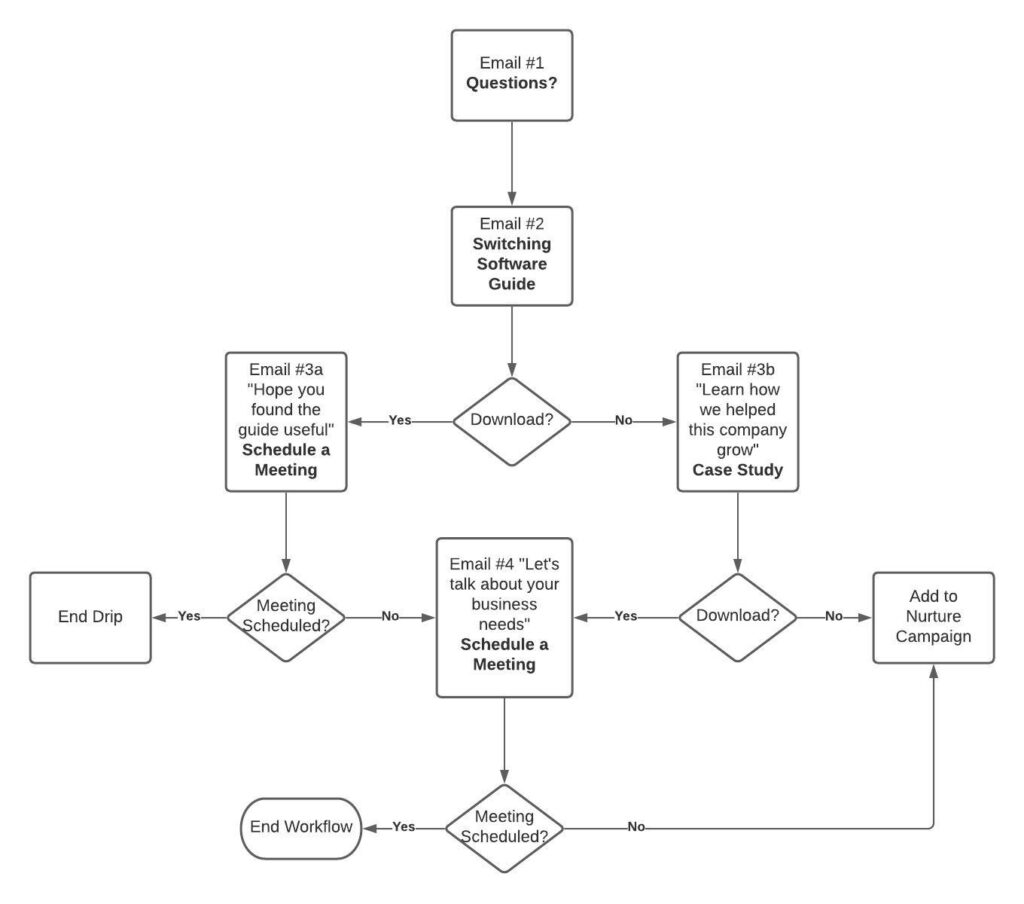B2B emails are the new cold call – but they’re also more than that. With over 3.7 billion email users worldwide, email is alive and thriving … and you should be participating. Whether they’re outbound, nurture or drip emails, put yourself in your prospect’s inbox and stand out from your competition.
To round out your complete 2021 B2B marketing strategy, you need to be thinking about all the different ways you’re communicating with customers and leads. This includes finding a way to write B2B emails that convert.
Let’s be real. How many times do you check your email a day? 10 times? 15? 30 times … an hour?
Exactly. Emails aren’t going anywhere. But, since your targets are checking their emails constantly, this probably means they’re receiving up to a hundred (or more) emails a day. How can you break through the noise?
Here are three types of emails you need to be writing to cover all of your email marketing bases (and exactly how to nail each type).

#1. Outbound B2B Emails
Ah, yes. The outbound email. Essentially a text version of those dreaded cold calls. Outbound emails are emails sent to people who haven’t heard of you yet – but, based on their background, they are likely to benefit from your offering.
It seems like a shot in the dark. Ask yourself: How many times have you deleted or ignored an email that came from someone you didn’t know?
We all do it. There’s simply not enough time in the day to get to every single email. However, this truth may be clouding your perspective of the effectiveness of cold emails. Yes, many people will ignore you. But even the small percentage of people that do engage with you after a cold email is worth it.
And speaking of it being worth it – outbound email is simple and cost-effective.
You can only make one sales call at a time. But you can send hundreds of emails at once. Email is fast, direct and much less intrusive.
(Just don’t get too crazy with mass emails. You still need to be targeted, relevant and personable.)
Just make sure you’re sending to a clean, verified list of opt-in contacts. You can get blacklisted if you’re spamming folks you don’t know. Make sure prospects can reasonably expect to hear from you before you reach out.
#2. Nurture Emails
Nurture emails spring from inbound marketing efforts. People have signed up to hear from you, or given you contact information in exchange for content.
But what happens if the contact goes silent? That doesn’t mean you should go silent, too.
The B2B sales cycle can be long. Just because someone isn’t ready to buy right now, doesn’t mean you’ve lost the opportunity. A nurture campaign is a great way to stay in front of these people as they go through the buyer’s journey and decision-making process.
Set up a weekly or monthly email that delivers tangible value to your reader, keeps you top of mind and provides them with the content they need to solve their problems – and get one step closer to becoming a customer.
(P.S. I’d be remiss not to highlight our Monday Marketing Tip emails in this section. Join 4,000+ B2B marketers and sign up for our weekly emails!)
#3. Drip Emails
Drip emails are similar to nurtures in the sense that they provide ongoing value to email subscribers.
The difference is how these emails are connected. A nurture campaign will send unrelated but valuable emails on a regular schedule. But a drip campaign is fully automated and will slowly “drip” helpful information, updates, and demo or consultation requests over time in a specific order, triggered by specific actions.
This type of campaign starts when someone takes an action—like downloads a checklist—which triggers the need for a response. Here’s an example of what this response might look like:
Example Drip Workflow

- Email #1: Asks the contact if they have any questions about the checklist they downloaded.
- Email #2: Offers another piece of content to download. The action of downloading is a good gauge of the contact’s continued interest.
- Email #3a: Thanks people who downloaded the content and offers help or a demo.
- Email #3b: Offers another (different) piece of valuable content to those who didn’t download the other one.
- Email #4: Makes the demo/meeting ask to those who have indicated interest by downloading content, and follows up one more time to those who didn’t schedule a meeting after email #3a.
You can create a lot of different automated paths in an email drip based on different actions and delay timelines. These can go on and on for a while. And they can get complex. But usually we see drips like this in the 3-5 email range.
Notice how the unengaged contacts get looped into the regular nurture campaign. Even though they don’t engage during this drip campaign, they could engage down the line when they’re ready to make a business decision. Always be clear with your objective when you set these drips up. In this example, the workflow goal is to schedule a meeting.
This is something you can execute in your marketing automation platform.
How to Write B2B Emails That Convert
Okay, now we know the three types of emails you should be sending. But how do you actually write better B2B emails? The following tips will help you write any type of email quickly and effectively.
#1. Be Personal
Personalization is important for all three types of emails.
People will ignore you if you aren’t speaking to their interests right away, no matter if it’s the first time you’re emailing someone in an outbound email or if you’ve nurtured them for six months.
Address the recipient by name in the subject line or the email body. Just make sure you have a clean list of first names before you use the personalization tools in your email platform. You don’t want to accidentally say something like “Dear Smith” instead of “John.”
Segment your list by different type of audiences so you can be more targeted in your email. This doesn’t mean you should send super technical and specific emails. This just means you’re writing content that you know will be relevant to a particular group of people. You don’t want to alienate any individual with overly technical topics.
Write like a human. You are a human after all, right? Just because you are representing a B2B company doesn’t mean your brand has to sound like a robot. Send the email from a company spokesperson and write like you’re a person talking to another person. If you wouldn’t say something you’ve written in an email out loud in a normal conversation, rework the sentence.
#2. Be Concise
Just like this tip, your emails should be short and sweet.
Get to the point quickly. People’s attention spans are dwindling, and, as mentioned, everyone gets hundreds of emails a day. You only have a small window to catch someone’s interest.
#3. Provide Value
Give your recipient a reason to open, read and even click through your email. The best way to do this is by focusing on being informative and helpful.
Answer specific questions. Offer tips. Don’t ask for too much right off the bat.
The recipient might not be ready to set up a lengthy demo with your team, but they might be interested in downloading a guide to learn more about a specific problem they are having. Give them time to learn why your company is the best solution for their needs.
#4. Time It Right
This will take some research and trial and error. Get a sense for when your audience is the most engaged and responsive. Then, send your emails accordingly.
We send our Monday Marketing Tip emails every Monday around 1 p.m. At this point, our audience knows to expect them. This has worked for us, but that approach might not work for you. Experiment with different dates and times.
Is it better to send it at the same time every week or month, or is it better to switch it up every time? Should you stick to the workday or send late night or weekend emails? “Best practices” will usually tell you to follow the latter of both questions. But email habits are always changing. Plus, what worked for you six months ago might not work well today.
#5. Use the Right Platform
There are a lot of email marketing platforms out there that you can choose from. Some are more robust than others, so it depends on your scale and specific use case. The important part is being able to generate data and actionable reports from your campaigns so you can make better decisions, which is something that can’t really happen if you’re only sending bulk emails from Outlook.
Here are some features that will help you with outbound emails, nurture campaigns and drip campaigns:
- Automation (for drip campaigns)
- Data merges (to pull the first name)
- Simple design builders
- Spam score checker
- Bounce & spam management
- List segmentation
- Campaign and recipient analytics (open rates, click rates, unsubscribes, etc)
Bottom Line: Know Your B2B Email Audience
All of the above tips can be summed up into one: Know your audience.
The better you know your audience, the better you’ll be at reaching and connecting with them.



